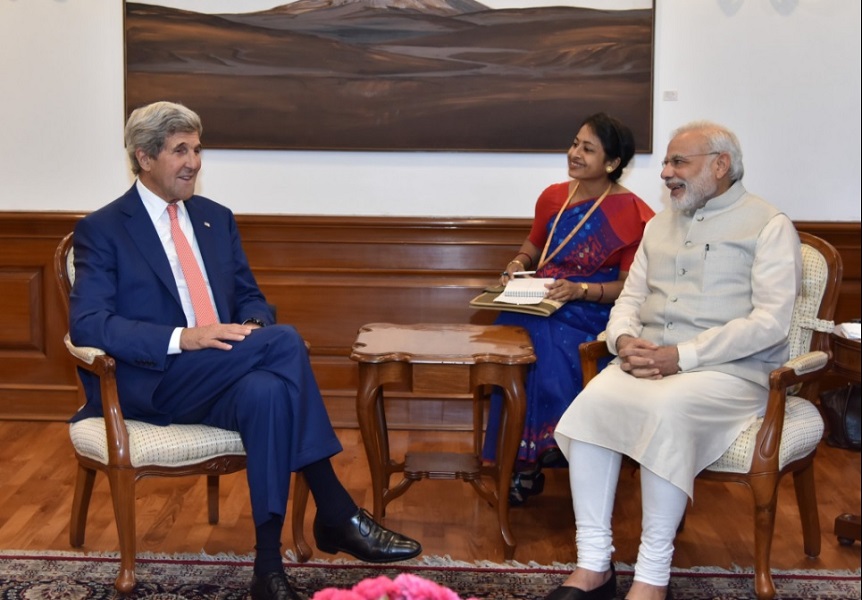
The elevation of the U.S.-India Strategic Dialogue to the Strategic and Commercial Dialogue and the signing of the Logistics Exchange Memorandum of Agreement (LEMOA) reflect a discernible shift in the strategic thinking of both India and the United States. Given India’s strategic location in the Indian Ocean region and the United States’ military presence in the Indo-Pacific with bases in East Asia and the Middle East, LEMOA portends a clear intention of both sides to take Indo-U.S. interoperability to the next level.
LEMOA, earlier called the Logistics Support Agreement (LSA), is a modified, India-specific version of the Acquisition and Cross-Service Agreement (ACSA) that the United States signs with a host of defense partners and allies. The LEMOA enables the militaries of the two countries to use each other’s bases for making repairs, replenishing supplies, refueling vessels, and other important logistical functions. However, in line with India’s historic concerns about aligning too closely with major powers, both countries crafted the LEMOA as an enabling agreement that allows India the flexibility to invoke all, parts, or none of the provisions at its discretion. This means that India possesses the right to accept or refuse American requests on a case-by-case basis, as per India’s assessment of its national interest.
Though achieving consistency in the relationship is still a work in progress, long-heldperceptions of India as a “reluctant partner” and the United States as an “unreliable power” seem to be on the decline. Over the years, it has become increasingly clear that both countries need each other to secure their national interests. The nature of these converging interests was noted in the U.S.-India Joint Strategic Vision for the Asia Pacific and Indian Ocean Region issued by Prime Minister Narendra Modi and President Barack Obama during the latter’s visit to India in January 2015. These core interests include ensuring stability in in Afghanistan, containing the rise of China, securing the sea lanes of communication, carrying out Human Assistance and Disaster Relief (HADR) operations, and ensuring freedom of navigation in the Indo-Pacific.
However, any further advancement in the relationship between India and the United States will depend on the new direction of American foreign policy. Despite the preeminence of American power in the international system, emerging discourse on U.S. foreign policy seems to portend a downsizing of American international engagement which has implications for India’s own strategic aspirations. Between the United States’ emphasis on burden sharing to maintain the global order and India’s vision to become a “leading power,” the two sides have an opportunity to re-calibrate their strategic partnership. Traditionally at the receiving end of decisions made in other capitals, India now desires to become a part of global agenda-setting. In this pursuit, besides developing national capabilities, India also needs to augment its partnership with countries like the United States.

Unpopular, costly wars in Iraq and Afghanistan have led the American strategic community to suggest either frugality in foreign policy ventures or nation building at home. It is in this context that one must view the American rebalancing strategytoward the Asia-Pacific and its closer relationship with India. This policy seems to be gradually but surely subsuming a larger geographical area under the new construct of the Indo-Pacific or the Indo-Asia-Pacific region. The rebalancing strategy essentially aims to preclude the rise of a peer competitor in the form of China and maintain a stable balance of power in Asia. Simultaneously, U.S. foreign policy seems to be moving towards some sort of a strategic devolution, commensurate with its desire to reduce its foreign presence. This entails cementing U.S. alliances in the Asia-Pacific and building new strategic partnerships like the one with India.
However, Washington’s complex interdependence with Beijing renders any strategy to contain China easier said than done, to the extent where concerns abound in India regarding the possibility of a United States-China power condominium to the detriment of India’s interest. Emerging Asian geopolitics will not play out sans the United States, thus meriting a sober assessment from New Delhi on where American foreign policy is heading, and what it means for the future of U.S.-India relations. A critical issue that merits great consideration on India’s part in the near future is Afghanistan. India’s internal debates regarding its role in Afghanistan range from consensual views on the positive impact of civilian assistance to differences over the more controversial issue of increasing military assistance. What transpires in Afghanistan, with a smaller American presence, has substantive implications for India’s security threat matrix, given India’s aversion to the Taliban’s influence and desire to limit Pakistan’s inroads in the country. This warrants more transparency regarding the scope and limitations of Indo-U.S. cooperation with Afghanistan at the India-Afghanistan-United States trilateral talks expected to be held on the sidelines of the United Nations General Assembly later this month.
There is now strong bipartisan support for deepening the United States-India relationship in both countries. However, if the proposition that the United States is on the cusp of significant change in its internal and external orientations is true, India must carefully assess the growing voice in the United States that American allies must pick up more of the burden. Although this pressure is unlikely to be directed at India, questions are bound to eventually emerge on what India brings to the global table. However, going beyond the vocabulary constraints of alliance or no alliance, alignment or nonalignment, it is more important to note that an India looking for a larger role at the international stage will have extraordinary opportunities as the United States looks for partners who are ready to pick up the slack in the global order. It requires both sides to acknowledge the value of shared interests and find new traction to take the strategic partnership forward.
***
Image 1: PMOIndia, Twitter
Image 2: Vikas Swarup-MEAIndia, Twitter


